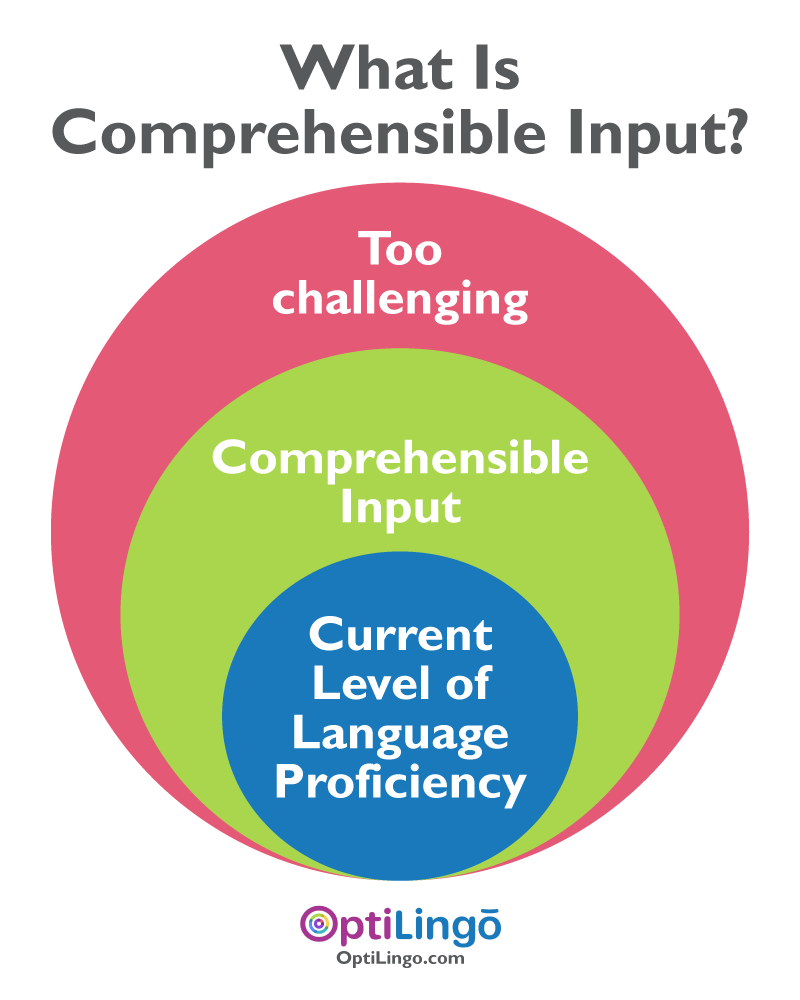What’s the Best Way to Learn a Foreign Language?
There’s only one thing more frustrating than wasting your time and money trying to learn a foreign language. And that’s wasting your time using a language learning platform that makes you THINK you’re learning a language only to find out (often embarrassingly) later on that you can’t. Despite the science, many platforms fall short of their promise to help you reach fluency because they fail to prioritize comprehensible input.
What Is Comprehensible Input?
Comprehensible input is language materials that you can experience and understand nearly all of the content presented. In short, it is language learning material in your target language slightly above your abilities. That way, you understand most (but not all) of it. In other words, it’s the Goldilocks Zone of language learning. Not too hard, not too easy.
Does Comprehensible Input Work?
If you’re going to learn a new language, you need to practice using language materials that aren’t too hard or too easy. When your lessons are too easy, you get bored and stop paying attention. Learning becomes a chore. When they’re too hard, you struggle and give up. That’s why at the core of any successful language learning program, you need comprehensible input.

Language Acquisition vs Language Learning
There’s a difference between acquiring a language and learning one. Children acquire languages subconsciously. They pay no attention to grammatical rules or memorization. Instead, acquire the language by using it, typically in play.
So, how do children learn language structures? They get a general understanding of the language by using it over and over again. They repeat what they hear and practice. For children, language is about necessity. Without it, they can’t get what they want. Over time, they avoid what is incorrect and communicate effectively at higher levels.
Learning a language is much different. Most people will experience trying to learn a language, usually in a classroom setting. The focus is more on the rules and speaking “correctly.” Students study the language. After a while, they’re tested on it over and over again. This puts a lot of stress and pressure on the learner to perform well as mistakes are often punished with bad grades.
Children, on the other hand, aren’t mentally prepared to understand the functions of language at this level. They play with the language instead. As a result, they more easily acquire the language.
To speak a language fluently, you need a program that gives you the opportunity to play with the language. You need a stress-free environment. And you need to avoid studying it like a subject. Instead, you want to use it as a tool. Do this, and you’ll learn any language fast.
What Is Krashen’s Input Hypothesis?
Stephen Krashen is a leading expert in linguistics who has focused mainly on how people acquire language. Many modern language learning theories base their ideas on his input hypothesis and the role of comprehensible input in helping people achieve fluency.
Krashen spent years watching how people acquire their second languages, and his results were shocking. In short, he discovered that we all learn languages the same. No one is gifted or special when it comes to language learning. Instead, they follow the path we all take to learn a new language. And as a result, they’re successful.
What Is the Input Hypothesis?
The Input Hypothesis is the theory of Second Language Acquisition Developed by Stephen Krashen. Why does this matter? Knowing it can help you to rewire your brain (and your mindset) for language acquisition. Using these methods, you can learn a language effortlessly. Without studying. Without boring grammar. And without the failed methods forced on you in language courses.
When done right, you won’t even realize you’re learning to speak a new language at all…

What Are the Five Stages of Language Acquisition?
The five stages of language acquisition make up the Input Hypothesis. Knowing them will give you a better understanding of how your brain acquires a language. And this will make it much, much easier for you to reach fluency in a foreign language. Check them out:
- Acquisition-Learning Hypothesis: We all learn a language in the same way. If we model how children acquire their first language we can experience more success.
- Monitor Hypothesis: We all plan, edit, and correct our speech based on our current understanding of grammar. But we only do it after we’re familiar with the rule AND only to polish up our speech. It’s not necessary.
- Input Hypothesis: Focus is on acquiring (not learning). You grow and improve with exposure to language learning materials that are one step away from your current abilities. Known as (i+1), where “i” is your current ability, and +1 refers to the level.
- Affective Filter Hypothesis: You need the optimal environment to help you learn. That means you need to feel high levels of self-confidence and motivation. You also need to learn in an anxiety- and stress-free environment.
- Natural Order Hypothesis: You learn grammar in a predictable natural order that cannot be rushed because you need to understand and know previous grammatical structures to learn new ones. That’s why you shouldn’t focus too heavily on grammar.
Why Foreign Language Classrooms Suck
You might be wondering why any of this matters, after all, they’re just theories right? More academia seems to lead to the same repetitive processes over and over again. You know, the ones that got you to give up learning a foreign language in the first place. Right? Not exactly.
Foreign language classrooms suck because they rely on dated methods. Tell me if this sounds familiar. You show up to a language class and soon after the bell, your teacher has you standing up, walking up to total strangers mumbling a greeting in a new language. You manage to survive and sit down only to spend the next 40 mins in horror, hoping you don’t get called on.
How can anyone reach fluency in a stressful environment?

Most can’t. That’s why people will spend years and hundreds of hours studying a language only to struggle through basic conversations. You can’t study a language like a subject. It’s not Math or History. It’s a tool to be used. And that’s what makes the input hypothesis and comprehensible input AMAZING.
It flips the language learning model.
The goal isn’t to rush you through a series of grammar lessons and force you to start speaking from day one. That’s not even how people learn languages! (When’s the last time you saw a toddler with a grammar book, right?). Instead, you take your time, absorbing language. And you only speak when you’re ready.
No grammar lessons. No verb conjugations. And no forcing you to stammer your way through a lesson you barely understand covering words you’ll probably never use, ones that have no interest to you. Instead, with comprehensible input, you acquire a language naturally and in a way that’s meaningful to you. It’s how you were SUPPOSED to learn a language.
What Is Optimal Input?
Optimal input is material based on your interests so that you find it irresistibly fascinating. The material would be so captivating that you’d forget you were even working towards fluency. The language seems to melt away and all you’re left with is content that you enjoy. These types of lessons should be every language learner’s goal.
Why Is Comprehensible Input SO Important?
We all live busy lives. The last thing anyone wants to do is waste what little free time we have trying to learn a language only to fail. But the need and desire to learn a foreign language is there, inside of you. You wouldn’t be here if it wasn’t. You’re just waiting for someone to tell you that your efforts won’t be in vain. That THIS TIME you won’t waste your time.
Comprehensible Input is the answer for those looking for a way to finally reach fluency. If you want to acquire language naturally in a way that’s stress-free, enjoyable, and makes you forget you’re learning, then you need a language program that focuses on comprehensible input…
How OptiLingo Uses Comprehensible Input
With OptiLingo, you’ll focus on useful, high-frequency phrases that you can review in a completely stress-free environment. There are no grammar lessons or silly phrases that you’ll never use. And you won’t have to deal with any anxiety around speaking in a foreign language. Instead, you’ll acquire a new language naturally.
Experience how comprehensible input can help you on your path to fluency by letting Optilingo guide you there. Try FREE today!








